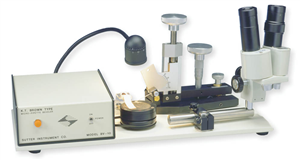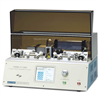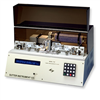

BV-10
Microelectrode Beveler
- Overview
- Specifications
- Accessories
- Citations
- Related Products
Overview

There are 1 images available to view - click to enlarge and scroll through the product gallery.
BV-10 Datasheet
/ Download as PDF
BV-10 Instruction Manual
/ Download as PDF
FEATURES
- Vibration-free, magnetically coupled beveling surface
- Abrasive surface optically flat to a half wave (250nm)
- Finest abrasive surface commercially available
- Synchronous clock motor insures stable rotation rate
- 7lb steel baseplate adds additional dampening
- Integrated LED lamp
- Robust micromanipulator controls bevel angle and advancement
Elegant and simple to use, the BV-10 offers precision beveling of micropipette tips between 0.1 and 100µm. The unique abrasive plate drive system is vibration free for greater control of the beveling process. Beveling can be accomplished very rapidly and produces consistent tip diameters using the techniques as described by Brown and Flaming, Science, August 1974, Vol. 185.
Intracellular recording electrodes can benefit from beveling because of:
- A reduction in the tip diameter by creation of the sharp point on the electrode
- A lowered electrical resistance of the electrode due to the larger cross sectional area of the lumen.
This greatly facilitates penetrating and holding very small or difficult cells. Microinjection needles also benefit from beveling by promoting entry into cells with minimal damage while at the same time enhancing the flow of material through the needle.
The basic beveling system consists of a stationary pedestal, optically flat to a half wave (250nm), surface mounted on a heavy baseplate. This serves as a bearing for an abrasive coated glass grinding plate, which is also flat to half a wave. The flat abrasive plate is coupled to a low vibration, slow-speed motor by means of magnetic fields to provide a wobble-free flat grinding surface. The abrasive plates are fabricated with a proprietary process which insures a consistent abrasive coating.
A 2-axis micromanipulator holds the pipette to be beveled and permits controlled advancement onto the abrasive surface. The bevel angle and speed of advancement are adjustable. An LED lamp with a gooseneck enhances the beveling operation by providing sharp illumination of the abrasive plate and pipette.
The basic system is completed with two abrasive plates of your choice, a wick with holder (for wet beveling), pedestal oil, degreasing fluid, and manual.
Two options are available for monitoring the beveling process, an 40X stereo microscope and an electrode impedance meter. Depending on your research application, one or both of these options may be desirable. For all micropipette applications, the swing mounted microscope enhances your control of pipette advancement onto the abrasive plate and allows for viewing of the beveling operation (scope resolution is not sufficient for viewing the actual bevel except in the case of very large tips). For microelectrode applications, the impedance meter is used to monitor the tip resistance during the beveling operation. The meter is an analog design, offering three resistance ranges (0-10, 0-100, 0-500 MOhm). Measurements are made at 12 Hz to minimize capacitive contributions to the impedance measured and provide a near-true DC resistance value. A rapid roll-off is used to reduce 50/60 Hz interference, allowing operation in a laboratory environment without screening.
Specifications
TECHNICAL SPECIFICATIONS
Beveling Range
0.1µm through 100µm finished electrodes depending on abrasive plate used
Grinding Surface Variation
less than 1.0µm
Grinding Speed
60 RPM
Beveling Angle Range
5-90 degrees - adjustable
Micromanipulator
course drive: 0.075in / dial revolution
fine drive: 0.0004in / dial revolution
Dimensions
19in x 9in x 8in | 48cm x 22cm x 20cm
Weight
30 lbs | 14 kg
Electrical
110-120v/200-240v | 50/60 Hertz power line
RoHS Certified
Part Numbers and Description
BV-10-B Micropipette beveler basic system*
BV-10-C BV-10-B with electrode impedance meter
BV-10-D BV-10-B with 40X stereo microscope
BV-10-E BV-10-B with impedance meter and 40X stereo microscope
*Includes micromanipulator, reference wick, reference wick holder, pedestal oil, degreaser, manual, and two abrasive plates of your choice.
ACCESSORIES
BV-10M Electrode impedance meter with active and reference lead
BV-10S 40X stereo microscope
104C Diamond abrasive plate - coarse (5.0µ to 50µ tip sizes)
104D Diamond abrasive plate - fine (2.0µ to 20µ tip sizes)
104E Diamond abrasive plate - very fine (0.7µ to 2.0µ tip sizes)
104F Diamond abrasive plate - extra fine (0.2µ to 1.0µ tip sizes)
007 Degreaser (bottle)
008 Beveler pedestal oil
REPLACEMENT PARTS
101 6-inch reference lead (body to meter)
102 2-inch active lead (platinum to pipette)
X050300 Reference wick
M100019 Reference wick holder
O664111 Halogen bulb
H906100 Drive belt
Accessories
Citations
Chen, B., Anchel, D., Gong, Z., Cotton, R., & Li, R. (2014). Nano-Dissection and Sequencing of DNA at Single Sub-Nuclear Structures. Small. Retrieved from https://onlinelibrary.wiley.com/doi/10.1002/smll.201400075/full
Delestrée, N., & Manuel, M. (2014). Adult spinal motoneurones are not hyperexcitable in a mouse model of inherited amyotrophic lateral sclerosis. The Journal of …. Retrieved from https://onlinelibrary.wiley.com/doi/10.1113/jphysiol.2013.265843/full
Eggleston, P. (2014). Docking systems for site-directed transgene integration. … Insects: Techniques and …. Retrieved from https://books.google.co.uk/books?hl=en&lr=&id=ECExBQAAQBAJ&oi=fnd&pg=PA51&dq=BV-10+sutter&ots=ATzYOr_xfy&sig=X97avq2Btiipw_qdwFmdeEgKDD0
Guthrie, M., & Kang-Mieler, J. (2014). Dual electroretinogram/nitric oxide carbon fiber microelectrode for direct measurement of nitric oxide in the in vivo retina. Biomedical Engineering, IEEE …. Retrieved from https://ieeexplore.ieee.org/xpls/abs_all.jsp?arnumber=6595558
Kai, T., Chen, S., & Monterroso, E. (2014). Microconcentric Ring Electrode/Injector Assembly for Sensitive Voltammetric Analysis in Single Droplets of Ultrasmall Volumes. Analytical Chemistry. Retrieved from https://pubs.acs.org/doi/abs/10.1021/ac502316p
Kiel, J., & Kopczynski, C. (2015). Effect of AR-13324 on Episcleral Venous Pressure in Dutch Belted Rabbits. Journal of Ocular Pharmacology …. Retrieved from https://online.liebertpub.com/doi/abs/10.1089/jop.2014.0146
Kurczy, M., Mellander, L., Najafinobar, N., & Cans, A. (2014). Composition based strategies for controlling radii in lipid nanotubes. PloS One. Retrieved from https://dx.plos.org/10.1371/journal.pone.0081293
Li, X., Gu, X., Boyce, T., Zheng, M., & Reagan, A. (2014). Caveolin-1 Increases Proinflammatory Chemoattractants and Blood–Retinal Barrier Breakdown but Decreases Leukocyte Recruitment in Inflammation. … Ophthalmology & Visual …. Retrieved from https://www.iovs.org/content/55/10/6224.short
Rossa, A. D. la, & Jabaudon, D. (2015). In vivo rapid gene delivery into postmitotic neocortical neurons using iontoporation. Nature Protocols. Retrieved from https://www.nature.com/nprot/journal/v10/n1/abs/nprot.2015.001.html
Stankovic, K., & Chandrakasan, A. (2014). Energy Extraction. US Patent App. 14/ …. Retrieved from https://www.google.com/patents/US20140247020
Sun, M., & Kaplan, S. (2014). Localized Drug Application and Sub-Second Voltammetric Dopamine Release Measurements in a Brain Slice Perfusion Device. Analytical …. Retrieved from https://pubs.acs.org/doi/abs/10.1021/ac5008927
Velho, T., & Lois, C. (2014). Generation of transgenic zebra finches with replication-deficient lentiviruses. Cold Spring Harbor Protocols. Retrieved from https://cshprotocols.cshlp.org/content/2014/12/pdb.prot084608.short
Xu, Q., & Guerrero, F. (2015). Use of electroporation as an option to transform the horn fly, Haematobia irritans, a species recalcitrant to microinjection. Insect …. Retrieved from https://onlinelibrary.wiley.com/doi/10.1111/1744-7917.12207/abstract
Zhu, H., & Grajales-Reyes, G. (2014). Fluoxetine is neuroprotective in slow-channel congenital myasthenic syndrome. Experimental …. Retrieved from https://www.sciencedirect.com/science/article/pii/S0014488614003446







Request
Catalogue
Chat
Print